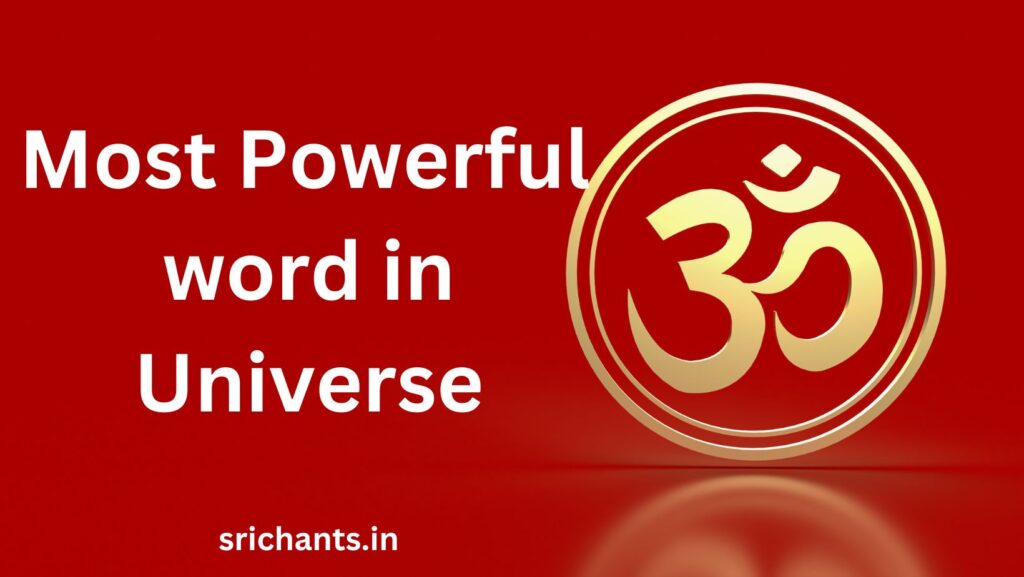Om: Aum : The most powerful word in the universe
Introduction
The Western world has been influenced by the counterculture of the 1960s, and the chanting and symbol of Om are now a well-known sight and sound to many. The genuine meaning of Om, which is deeply ingrained in Hindu philosophy, has a profoundly transformative impact on the physical, emotional, and spiritual realms of the practitioner. It is frequently linked to meditation and yoga. In order to gain a comprehensive understanding of the importance of this primordial sound, it is necessary to investigate the complex mechanisms of sound vibration and its relationship to the fundamental essence of the universe.
The Science of Sound Vibration
Sound is a multifaceted phenomenon that involves the interaction of vibrations, rather than merely being audible. These vibrations are generated by a source, propagate through the atmosphere, and are subsequently processed by the human brain. The frequency is the number of vibrations per second, and since all matter is composed of atomic material in constant motion, everything in the universe vibrates at a specific frequency.
Nikola Tesla, the esteemed inventor and physicist, once stated, “If you wish to uncover the mysteries of the universe, consider energy, frequency, and vibration.” When investigating the profound significance of the Om mantra, which is defined by Hindu scripture as the primordial sound of creation – the original vibration of the universe from which all other vibrations manifest – this insight remains valid.

The Primordial Sound of Creation
A sacred syllable that encompasses the three fundamental sounds of the Sanskrit alphabet: A, U, and M is the word Om, or Aum. The triadic conceptions represented by these three sounds are numerous and varied, such as the three worlds (earth, atmosphere, and heaven), the three qualities of matter (goodness, passion, and darkness), and the three sacred Vedic scriptures (Rigveda, Yajurveda, and Samaveda). In this manner, the Om mantra mystically embodies the essence of the entire universe, acting as a distillation of spiritual wisdom.
The Transformative Power of Om
It is widely recognized that sound vibrations have a substantial influence on an individual’s emotional, mental, and physical well-being. Practitioners can ensure that their frequency is in harmony with the original universal frequency, which is crucial for spiritual practice, by chanting Om. According to the ancient Hindu literature, “As an iron rod becomes as hot as fire when it comes in contact with its flames, a person can spiritualize their life by staying in contact with the spiritual energy of the Absolute.”
The Role of Om in Meditation and Spiritual Practice
The mind and senses can be transformed through the sound vibration of Om, which is the germ of transcendental sound. The mind is brought into alignment with the respiration through the chanting of Om, which allows the practitioner to achieve a state of heightened consciousness known as “samadhi.” This state of singular concentration on spiritual realization is indispensable, as the Absolute is beyond the comprehension of the ordinary material senses.
The Multifaceted Symbolism of Om
The Aum symbol, or Om, is not merely a visual representation of the sound; it is a potent icon that encompasses the full range of Hindu philosophy and spirituality. The three curves of the symbol symbolize the three states of consciousness: profound sleep, dreaming, and waking. The fourth state, “turiya,” is symbolized by the dot at the top. This state is characterized by pure consciousness that transcends the material domain.
The Significance of Om in Hindu Scriptures
The Om mantra is exhaustively discussed in numerous Upanishads, which are the speculative philosophical texts of Hinduism. One Upanishad, the Mandukya Upanishad, is exclusively dedicated to the investigation of the Om mantra. Furthermore, the Om symbol has been appropriated for sectarian use in the Puranas, the Hindu mythological texts. The Shaivites use the Om symbol to mark the “lingam,” or sign of Shiva, while the Vaishnavites identify the three sounds as referring to a trinity consisting of Vishnu, his wife Shri (Lakshmi), and the worshiping individual.

The Universality of Om
Although the Om mantra is profoundly rooted in Hindu tradition, its significance has surpassed religious boundaries, establishing a place in the spiritual practices of Jainism and Buddhism. The sacrosanct Om is incorporated into the primary mantra in Buddhism, “om mani padme hum,” which serves to underscore the transformative power and universal appeal of this primordial sound.
The Adoption of Om in the West
Om’s symbolism and chanting have become increasingly popular in the West, particularly since the counterculture movement of the 1960s. This increase in interest has been fueled by the increasing recognition of the advantages of yoga and meditation, which frequently involve the recitation of the Om mantra. As a growing number of individuals pursue holistic approaches to spiritual development and wellness, the timeless wisdom of Om continues to captivate and motivate individuals from a variety of backgrounds.
The Transformative Effects of Om Meditation
The profound impact of Om meditation on the human body and mind has been the subject of numerous studies that have investigated its physiological and psychological effects. Regular practice has been demonstrated to lower blood pressure, improve cognitive function, and reduce stress, in addition to fostering a more profound sense of spiritual connection and inner calm.
The Versatility of Om in Spiritual Practices
In addition to its application in meditation, the Om mantra is a fundamental component of numerous Hindu religious rites and domestic ceremonies. In the ceremony of initiation into numerous Hindu sects, the guru (spiritual teacher) whispers a confidential mantra, such as Om, into the initiate’s ear. This ritual emphasizes the conviction that mantras are truly effective only when they are received directly from a spiritual preceptor.
The Enduring Legacy of Om
In addition to its application in meditation, the Om mantra is a fundamental component of numerous Hindu religious rites and domestic ceremonies. In the ceremony of initiation into numerous Hindu sects, the guru (spiritual teacher) whispers a confidential mantra, such as Om, into the initiate’s ear. This ritual emphasizes the conviction that mantras are truly effective only when they are received directly from a spiritual preceptor.
Conclusion
The Om mantra is a testament to the transformative power of sound vibration and its capacity to alter the human experience. Spiritual enlightenment, emotional well-being, and a more profound connection with the essence of existence can be achieved by aligning our consciousness with the primordial frequency of the universe. We continue to uncover the mysteries of the universe, one vibration at a time, as we continue to investigate the multifaceted significance of Om.
#om #aum #ohmsymbolism #omsymbolism #aumommeaning #definitionofom #ommeaning








